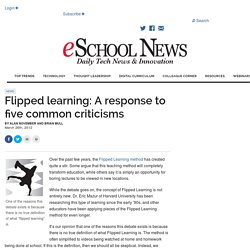

Flipping The Learning – My Big Campus. Tools and Tips for the Flipped Classroom. Flipping the Classroom - Simply Speaking. Ideas About the Flipped Classroom. Can All Classroom Lessons be Flipped? I’ve been following articles on the Flipped Classroom Model for some time now. Because my school has a 1:1 MacBook Pro environment, flipped classrooms are very feasible – students have continual access to technology both at home and at school. While I see the advantages of a Flipped Classroom, I note weaknesses that must be addressed. In a Flipped Classroom, students view instructional videos at home. Classroom time is then used for cooperative learning or project-based learning where students move beyond the knowledge-level mastery to analysis, synthesis, and evaluation.
Rather than lecture during student contact time, teachers directly interact with individual students and student groups. My concern is that proponents of Flipped Classrooms implement an “all or nothing” approach. I propose that educators start talking more about Flipped Lessons than Flipped Classrooms. Flipped Lessons enable teachers to better differentiate instruction within the classroom.
Like this: Like Loading... The truth about flipped learning. By Aaron Sams and Brian Bennett Read more by Contributor May 31st, 2012 Ultimately, flipped learning is not about flipping the “when and where” instruction is delivered; it’s about flipping the attention away from the teacher and toward the learner.

A flipped classroom is all about watching videos at home and then doing worksheets in class, right? Wrong! Consider carefully the assumptions and sources behind this oversimplified description. Is this the definition promoted by practitioners of flipped classrooms, or sound bites gleaned from short news articles? Many assumptions and misconceptions around the flipped class concept are circulating in educational and popular media. Assumption: Videos have to be assigned as homework. Although video is often used by teachers who flip their class, it is not a prerequisite, and by no means must a video be assigned as homework each night. Resulting misconception: Videos are just recorded lectures.
Let's Flip! Flipped learning: A response to five common criticisms. One of the reasons this debate exists is because there is no true definition of what “flipped learning” is.

Over the past few years, the Flipped Learning method has created quite a stir. Some argue that this teaching method will completely transform education, while others say it is simply an opportunity for boring lectures to be viewed in new locations. While the debate goes on, the concept of Flipped Learning is not entirely new. Dr. Eric Mazur of Harvard University has been researching this type of learning since the early ’90s, and other educators have been applying pieces of the Flipped Learning method for even longer. It’s our opinion that one of the reasons this debate exists is because there is no true definition of what Flipped Learning is. Dr. Taking a Risk on At-Risk Kids.
Eric Mazur shows interactive teaching. The Flipped Classroom: Pro and Con. I recently attended the ISTE conference in San Diego, CA. While I was only there for about 36 hours, it was easy for me to pick up on one of the hottest topics for the three-day event. The "flipped classroom" was being discussed in social lounges, in conference sessions, on the exhibit floor, on the hashtag and even at dinner. People wanted to know what it was, what it wasn't, how it's done and why it works. Others wanted to sing its praises and often included a vignette about how it works in their classroom and how it transformed learning for their students.
Still others railed that the model is nothing transformative at all and that it still emphasizes sage-on-the-stage direct instruction rather than student-centered learning. What It Is The authors go on to explain that the model is a mixture of direct instruction and constructivism, that it makes it easier for students who may have missed class to keep up because they can watch the videos at any time. What It Isn't.
Five-Minute Film Festival: Flipped Classrooms. I really enjoyed Mary Beth Hertz's excellent blog published earlier this week, "The Flipped Classroom: Pro and Con" -- one of the most concise and balanced views I've read on the buzz-wordy concept of flipping the classroom.

Advocates say that "flipped classrooms" help overburdened teachers differentiate their instruction to reach more learners, provide an avenue into more hands-on and student-driven learning during classtime, and shift the teacher's role from "sage on the stage" to learning coach and facilitator. Critics say it's just a fad, relies too heavily on rote instruction, and doesn't go far enough in making the needed changes for teaching and learning reform. I've rounded up this list of videos so you can learn more about the challenges and benefits of flipped classrooms. Video Playlist: Flipping the Classroom Keep watching the player below to see the entire playlist, or view this playlist on YouTube.